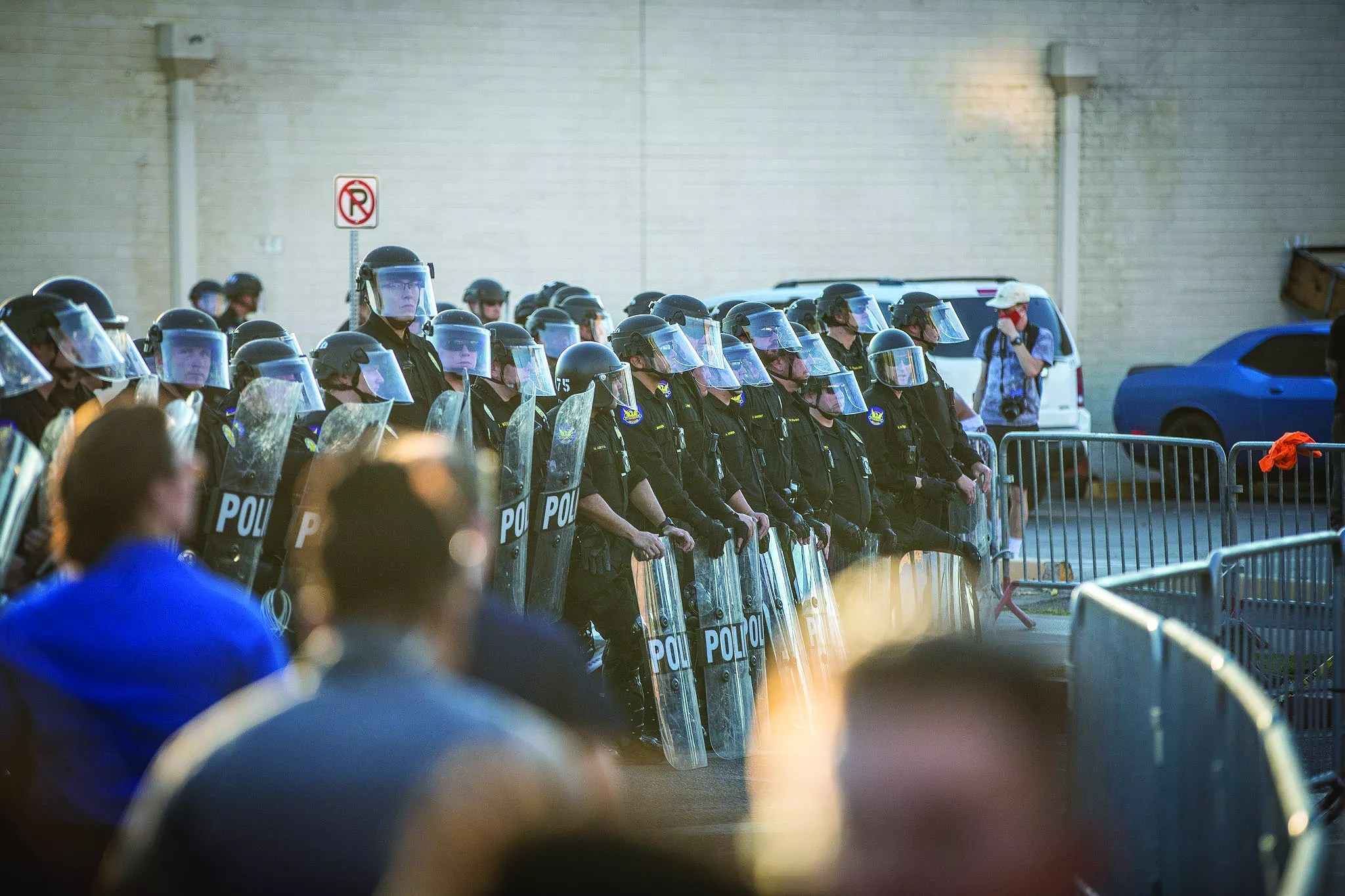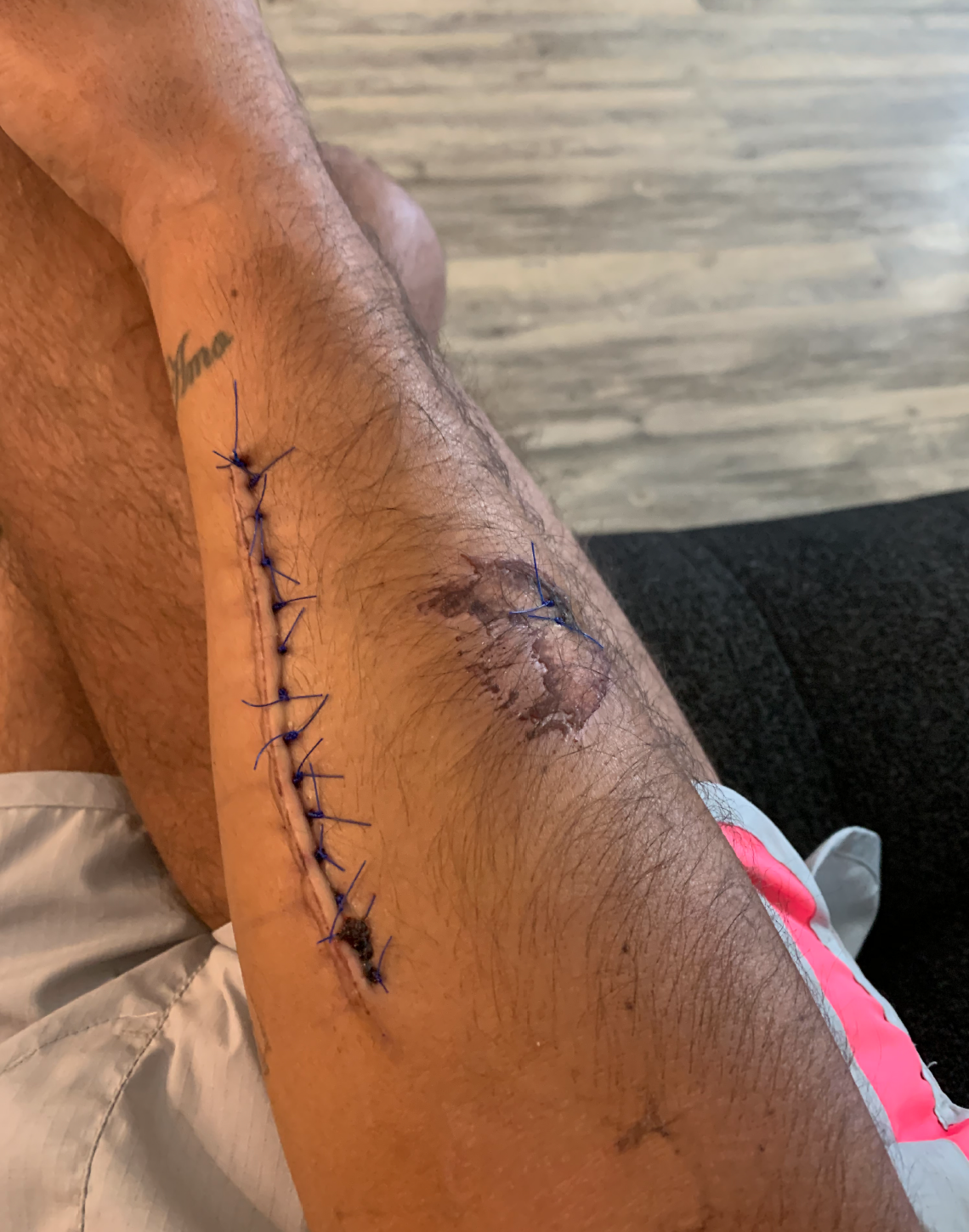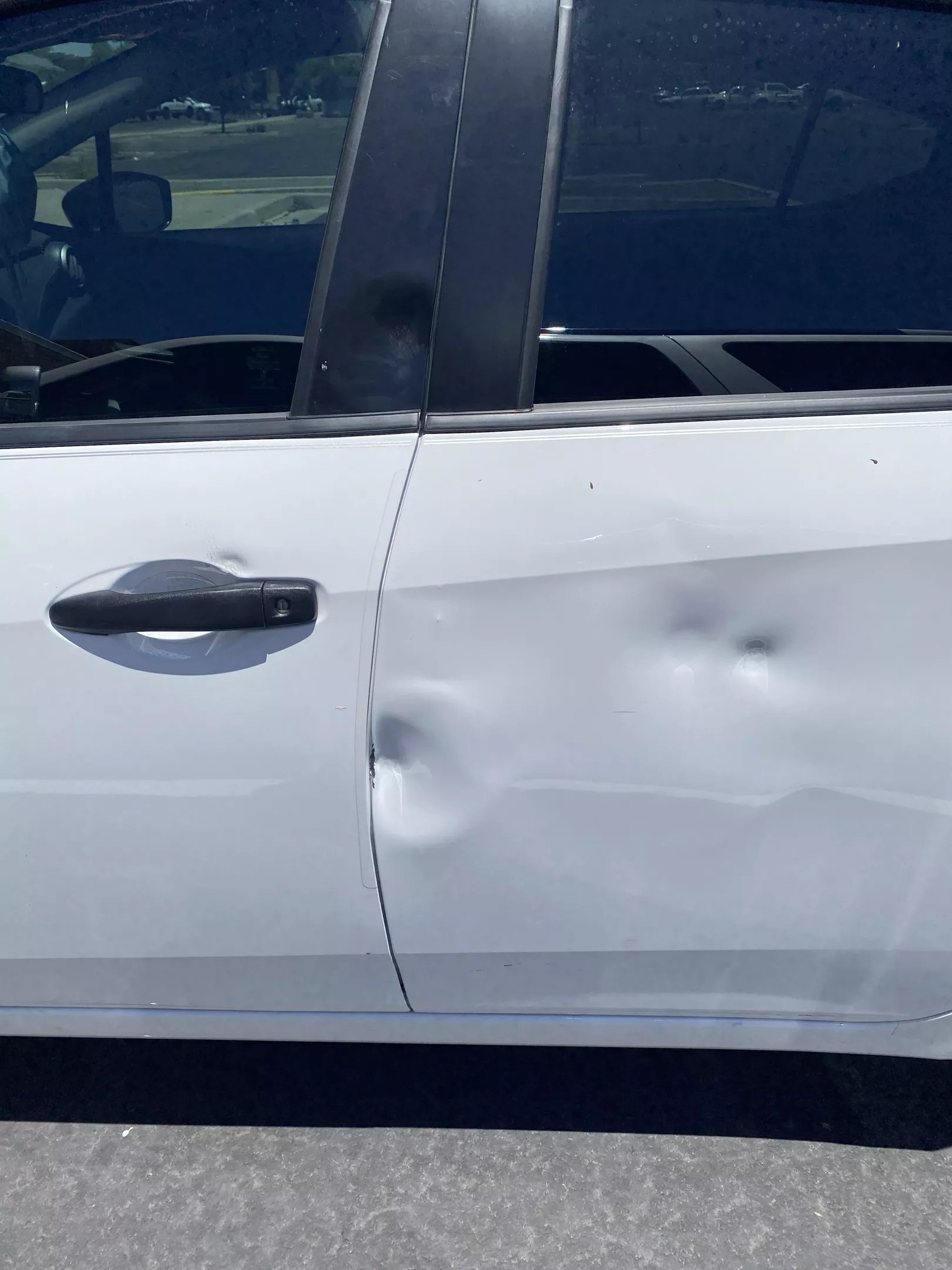
Jacob Tyler Dunn

Audio By Carbonatix
When David Saccoccio decided to join the nightly protests in Phoenix over police brutality and systemic racism, he didn’t think that he’d walk away with a broken arm – let alone a life-altering injury caused by a police officer.
“We were trying to get home and they shot me,” Saccoccio, a 31-year-old Phoenix-based bartender and hairdresser, told Phoenix New Times. “It’s so fucked up because this is the one entity in the government that is supposed to protect us.”
The weekend after a Minneapolis police officer killed George Floyd and daily protests rocked the nation, Saccoccio was protesting with demonstrators outside of the Phoenix Police Department headquarters downtown. But what started as a nonviolent protest on the night of May 31 ended with tear gas, rubber bullets, people getting chased around Phoenix’s Garfield neighborhood by police, and mass arrests of hundreds of protesters for violating the nightly curfew imposed by Governor Doug Ducey that same day in response to looting and vandalism in Phoenix and Scottsdale.
“The first doctor and nurse told me that it was unbelievable that they made me wait that long to get attention for the kind of break it was.” — David Saccoccio
Saccoccio landed in the hospital after a Phoenix police officer fired a beanbag round – a less-lethal form of munition used by law enforcement – at him at “point-blank range” and fractured the radial bone in his forearm.
“They weren’t out there to protect us,” Saccoccio said. “It was like a game of manhunt.”
Today, he’s in constant pain and goes to weekly physical therapy sessions. A bartending job that he had lined up has fallen through because his arm doesn’t work like it used to. On top of that, when his current health insurance cuts off at the end of July, he’ll have to deal with the financial costs of the ongoing physical therapy. Now he’s contemplating what to do next, since he can’t work in the restaurant industry and the COVID-19 pandemic is wreaking havoc on the economy.
“My right arm is my money-maker,” Saccoccio said. “Now I suffer forever. Do I go back to school? Given the times, what’s the right industry?”
Saccoccio decided to sue the City of Phoenix and Phoenix Police Chief Jeri Williams, alleging civil rights violations. And he isn’t alone: Several other protesters arrested the night of May 31 are also suing, making similar allegations, including excessive force.
One plaintiff, Christina Chavez, was driving to her home in the Garfield neighborhood after attending the downtown protest when her car was bombarded by bean bags and birdshot from Phoenix police stationed nearby, according to court documents. Another demonstrator and plaintiff, Yohan Stokes, was hit by rubber bullets along with other protesters after police chased them through the Garfield neighborhood and cornered them against a wall. The filings also state that residents of the neighborhood “opened their homes” to protesters, “trying to protect them from the obvious abuse by police.” But as homes “filled up,” they started providing advice on how to leave the area.
“Phoenix police did not even allow people to leave,” said Steve Benedetto, an attorney with The People’s Law Firm, which is representing Saccoccio. “They gave protesters no opportunity to go back to their cars. They just started tear-gassing people, hunting them down in the Garfield neighborhood, and arresting them. It was a flagrant disregard for constitutional protections.”
Here’s how the night went down, according to Saccoccio and the various court filings:
After demonstrators protested outside of the Phoenix Police Department for a few hours, rumors spread that police were about to close the freeway and access to downtown, prompting many attendees to head for their vehicles in an attempt to leave. Some remained behind and ended up walking north on 7th Street, where they were met with a “lengthy riot line” blocking off the road near Roosevelt Street. Then the officers fired tear-gas canisters and rubber bullets at the crowd.
The protesters ran south to escape the volley, but were met with another line of officers at 7th Street and Van Buren Street, who also fired tear gas at them. They then tried to run back into the downtown area but were confronted with police barricades. So they turned east and headed into the Garfield neighborhood.
As Saccoccio tells it, that’s when he and other demonstrators started realizing that the police were trying to herd them and eventually trap and arrest them. During the previous three nights of demonstrations, which Saccoccio had been present for, police had used tear gas to try and get protesters to disperse. This night felt different, he said. It felt like they were being hunted.

David Saccoccio
David Saccoccio
“They were herding us together, and I remember running and I looked at my friend. I said … ‘They’re herding us, they’re trying to cattle us together’,” he said. “We wanted to go home. At that point, my friend was starting to get watery-eyed. I was panicking inside.”
What ensued was a chaotic game of cat-and-mouse in the Garfield neighborhood, with police chasing protesters.
“In the neighborhood, Mr. Saccoccio and other protest participants ran from street to street, trying to find their way back to their vehicles to leave,” the filing states. “As they did so they heard the sounds of helicopters overhead intermingling with constant gunshots, saw the lights of police vehicles racing around them, and saw tactical teams of police officers chasing down protestors and trapping them so that they could tear-gas and shoot them with rubber bullets.”
“We were definitely super-scared. They were trapping us in the alleys, there were no street lights in this neighborhood,” Saccoccio said. “It was next-level tactics.”
At one point, Saccoccio and his friend got cornered by a fence. He heard a police officer yell “get down,” so he turned around and started to put his hands up. That’s when he got hit by the beanbag round.
“It was so fast,” he said. “I just remember looking at my arm and blood started coming out of my arm super-fast. I didn’t feel pain. I just remember holding my arm saying, ‘I’m hit, I’m hit.’ I was in shock.”
He was soon detained and forced to lay face-down on the street. As his arm started to swell up and grow painful, Saccoccio asked the officers for help. But he was rebuked, and, in his recounting, mocked. Meanwhile, officers allegedly talked among themselves about how many protesters they’d rounded up.
An officer “put me on the ground, face down, and I had already started asking for help with my arm. He told me to ‘be quiet and shut up’,” he said. “They started shining their lights on me saying ‘Oh, that’s just a scratch.'”
“I needed help,” Saccoccio said. “I was crying. It was like sharp pain. When I was laying face-down, my arms and fingers started to go numb and cold right away.”
“Some guys were just walking around joking,” he added. “It was so crazy that you could be sitting there, crying, telling them that ‘my arm is cold,’ and there was no help. Where’s the morality in that? You shot me and now I can’t have any help?”
According to both Saccoccio and the filing, a supervising officer chastised the officer who shot him, identifying him as a “trainee.”
It would be several hours until he would receive medical attention, Saccoccio said. After being detained on a curb for about three hours, an EMT with the Phoenix Fire Department showed up, poured water on his arm, and wrapped it in gauze. Then Saccoccio, along with other detained protesters, was transported to a Phoenix police precinct for processing. There, officers took pictures of his arm.
Finally, five hours after he got hit, officers dropped him off at a Banner hospital. Medical staff told him that his radial bone was broken and he needed surgery. Saccoccio spent two nights at the hospital and had a “permanent four- or five-inch plate” inserted into his arm.

Saccoccio’s arm post-surgery
David Saccoccio
“The first doctor and nurse told me that it was unbelievable that they made me wait that long to get attention for the kind of break it was,” he said.
Sergeant Mercedes Fortune, a spokeswoman for the Phoenix Police Department, did not respond to New Times’ request for comment on the lawsuits, Saccocio’s case, or the various allegations made in the filings.
According to documents submitted to the Phoenix City Council from city staff, the Phoenix Police Department, and other agencies regarding the protests, after officers used less lethal munitions to “dissuade the crowd” at 7th Street and Roosevelt from “encroaching upon the freeway” that night, protesters started independently moving east into the Garfield neighborhood.
“Officers were aware of social media chatter regarding potential targets for demonstrators. A number of posts indicated protestors would demonstrate in residential neighborhoods, cause damage and physically assault non-involved
residents,” the document states. “This was taken into consideration as the group of demonstrators fled into the Garfield residential neighborhood. When demonstrators ran into the Garfield neighborhood, officers began making arrests for violation of the Governor’s curfew order. A number of arrests were made as demonstrators jumped over fencing into residential homes and ran through residential yards.”
An estimated 200 protesters – Saccocio among them – were arrested that night for violating the governor’s curfew.
Saccoccio now struggles with basic tasks.
“I was trying to cut up a banana into slices the other day, and I couldn’t even get through cutting the whole banana,” he said. “My wrist, I’ve never had problems until now. I have numbness all through it.”
His lawsuit accuses the Phoenix police of excessive force in violation of the Fourth Amendment of the Constitution. He’s seeking damages.
During the nightly protests prior to the evening of May 31, other protesters also report encountering an aggressive police response. Talleeah Alvarado, 20, was leaving downtown in her car in the early morning of May 31 after attending a protest on Saturday night when, as she tells it, police started firing rubber bullets at her car.
“They told everyone to leave and then we proceeded to leave and [they] blocked everyone in and started arrested everybody. I was already in my car and was already leaving. As I turned the corner there was a motorcycle and a police car. They hopped out and shot a rubber bullet at my windshield,” Alvarado, 20, told New Times. “I park[ed] my car, I wasn’t moving, I wasn’t doing anything, I had my head ducked down, and they’re still shooting at the side of my car. There’s about five or six dents in my driver-side, because they kept shooting at my car.”

Alvarado’s car after Phoenix police allegedly fired rubber bullets at it while she was driving away from a protest.
Talleeah Alvarado
“I was terrified for my life,” she added. “I was like ‘Oh my god, those bullets at a close range are lethal’.”
She was eventually torn out of her car by police and arrested along with numerous other protesters. At the precinct, they were charged with felony rioting, but the charges were later dismissed. Alvarado said that she was held with other protesters in a room in a police precinct for over ten hours as they were processed before they were eventually booked into jail. Her charges were eventually dropped. Now, she’s left with a car dinged up from the rubber bullets.
James Palestini, a defense attorney who represented Alvarado and over a dozen other demonstrators who arrested that night, said that Alvarado’s experience wasn’t unique.
“I’m not trying to be over-dramatic: They were ripped out of their vehicles, they were held at gunpoint, the officers used intimidation tactics, shooting at the vehicles,” he told New Times. “A lot of these people were just trying to leave the area. They weren’t rioting or doing anything wrong.”
Phoenix police allegedly arrested 114 people on the evening of May 30 and detained them “for hours in vans and precincts” and eventually booked them into jail for the “same exact charge (felony rioting),” the filings state. To justify those arrests, Phoenix police allegedly “‘copy-and-pasted’ the same generic probable cause statement.”
The Phoenix Police Department has spent approximately $6.4 million in response to the protests, including $6.1 million for staffing costs; $331,000 for supplies and equipment; and $25,000 for repairs in damaged vehicles, according to documents submitted to the Phoenix City Council. A total of 353 arrests were made in the first four days of protests in Phoenix for offenses like unlawful assembly, rioting, and violating the governor’s emergency order.
Benedetto, Saccoccio’s attorney, said that the aggressive response from Phoenix police on May 31 is reflective of a “consistent pattern” from a department that has “very little patience for non-violent first amendment protest.”
“Typically, the First Amendment guarantees the right of the people to peaceably assemble, which means that people can protest non-violently indefinitely, and the police have no ability to clear anybody from a non-violent protest,” he said. “The nights prior, when people were downtown and by the police station, they would say ‘This is the yada yada, disperse, get out of there.’ But [on May 31] there was none of that – there was no warnings.”
“This was a deliberate effort to send a clear message to a lot of young, first-time protesters, what the cost is for exercising their First Amendment rights,” Benedetto added. “And that is that the Phoenix Police Department will tear-gas you, they won’t allow you to disperse, they’ll hunt you down, they’ll zip-tie you, and then they’ll book you into jail.”